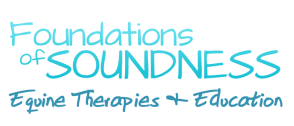When my hands are quiet and still on a horse, it can look like I am doing nothing. Yet, these moments are often when the most is happening. Sometimes, it feels like there is a storm brewing below the surface. Sometimes, the horse will get an itch in a distant area, or suddenly turn their head, fixated on me, as if to say, “What was THAT?!”
In 2013, I undertook two courses in equine myofascial release with Ruth Mitchell-Golladay. The participants worked on each other before applying the techniques to the horses, so that we could understand what myofascial release actually felt like, and what to expect. To further this, we all experienced a demonstration from Ruth’s experienced hands.
My deeply intuitive partner described some of the sensations as like a whirlpool, or riding a wave. Often, we would feel as though the therapist’s hands had moved the entire length of our back, when in reality they hard hardly moved at all. Once the restricted and dysfunctional tissue began to melt, it would continue to do so under sustained pressure, even if we felt we could not move our hands yet.
I had begun working this way some time ago, quite instinctively, as I tried to listen to what the horses needed in order to kick-start their healing and release. I had found that just massaging away often was not enough to reach the real dysfunction. I undertook Ruth’s courses hoping that she could clarify some of the things I was feeling and observing, and how to follow through more effectively. I certainly got that, and much more.
Myofascial release is not the be all and end all of treatment, but working in this conversational, gentle way is certainly a core part of my practice. As the title of the book “What’s in Your Web?” suggests, many emotional and physical scars manifest themselves in the body’s continuous fascial web. No sensation or feeling surprises me anymore when I am working with a horse.
The thing is, these are real, physical releases of real, physical problems – but they are often intertwined with emotions and mental states. It doesn’t matter which came first – the physical or emotional trauma. When either is not addressed, they become ingrained and inseparable as far as the patient is concerned, often on an entirely subconscious level.
The title of Ruth’s book, “Facilitated Healing Through Myofascial Release” describes our role perfectly. The mantra, “don’t judge, just follow”, further emphasises the point.
The therapist facilitates healing on a deep level by providing the catalyst for the body to open up old wounds and restrictions, and begin to heal itself. We trust the body to know what it needs once we have begun the process. Sometimes it can feel a little like opening Pandora’s box, but we don’t judge; we just follow, and facilitate the healing and release the body tells us it needs.
To do so, we trust the sensations under our hands; the vacuum or river that leads us in a direction we didn’t expect; the whirlpool that won’t let us move away; the barrier that says, “I haven’t melted enough yet”. I trust these sensations more after experiencing them as a patient – feeling an area of my back or neck suddenly start to crave release, and the therapist’s hands finding their way without my saying a word.
We trust the horse’s responses, and respect their fear if they say, “I can’t go there right now”. We work within their acceptance, and wait for that emotional barrier to melt just as the physical barriers inevitably do. That is rarely a one-session barrier; sometimes it can take many. The horse knows what it needs, and what it can handle; we can facilitate and suggest, but we cannot force.
We wait for the melt. And then, we can follow, and facilitate freedom.
Disabled and doubly neurodivergent human, former equine anatomist and bodyworker (no longer practicing due to Ehlers Danlos Syndrome complications), experienced equine advocate and educator, and budding disability advocate turning my sights on Australian Government policy and practice while elevating lived experience in research for horses and humans alike.
This blog is currently inactive but I occasionally check in on Facebook. Please check out the articles I keep it alive for and take something home to your horse ❤️



Wonderful writing! Thank you…. In practitioner too here in the US 25 years.
Beautifully written description of the interface when healing happens.